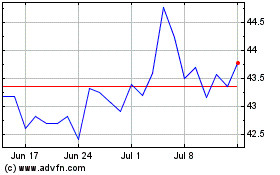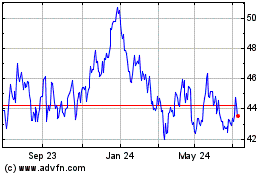In South Australia, Blackout Shuts Mines, Reignites Renewables Debate -- Update
September 29 2016 - 12:54AM
Dow Jones News
By Rhiannon Hoyle and Rob Taylor
SYDNEY-A statewide blackout in South Australia caused mining
operations including a large copper mine run by BHP Billiton Ltd.
to be suspended and reignited a nationwide debate over renewable
energy, which the state relies on heavily for power supplies.
South Australia, the country's fourth-largest state by area, was
continuing to experience widespread power outages on Thursday after
wild storms led to blanket power outage the prior day. Australia's
Bureau of Meteorology said strong-to-gale-force winds, abnormally
high tides and heavy rainfall were lashing the state.
BHP Billiton said its mine and processing facilities at Olympic
Dam, one of the world's biggest deposits of uranium, copper and
gold, were shut down after the state lost power on Wednesday.
"Back-up generators are currently providing power to critical
infrastructure and will allow a restart of operations when power is
restored," a spokesman said in an emailed statement.
Oz Minerals Ltd., an Adelaide-based copper and gold miner, said
its Prominent Hill mine in central South Australia, about 200 miles
from Olympic Dam, had also been suspended. "The company has not yet
received any definitive timeline as to when power will be restored
to the site as suppliers determine the full extent of damage to
their transmission networks," Oz Minerals said in a statement on
Thursday.
The fallout from the storms reopened a long-running national
debate about the role of renewable energy in Australia's
electricity grid, currently dominated by fossil-fuel generators
relying on plentiful coal and natural gas.
South Australia, governed by center-left Labor opponents of
Prime Minister Malcolm Turnbull's ruling Liberal-National
coalition, relies on wind and solar generation for 41.3% of its
electricity needs, against a national average of 14.6% last year,
according to Australia's Clean Energy Council.
Some federal lawmakers pointed to South Australia's aggressive
shift toward renewable energy as a major reason for the statewide
outage, saying that unlike fossil-fired generation it was
inherently more intermittent and weather-dependent.
But South Australian Premier Jay Weatherill said the storm had
been "a weather event, not a renewable energy event." Photographs
posted on his Facebook page showed images of large power pylons
bent over and flooding.
Australian Energy Market Operator, which is responsible for
operating the country's largest gas and electricity markets, said
initial investigations have identified the root cause of the
blackouts as likely to have been the loss of multiple 275-kilovolt
power lines during the severe storm. The power lines form the
backbone of South Australia's power system.
The reason why there was a cascading failure of the network
after that is still being looked into, it said.
Origin Energy Ltd., one of the country's largest energy
suppliers, said its two gas-fired power stations in the state were
helping supply power to the state and the company was working with
authorities to resume supplies of electricity.
SA Power Networks, which operates a distribution network across
South Australia, warned people in the state to be prepared for
extended outages. As of Thursday morning, Australian Energy Market
Operator said about 70,000 of 850,000 customers in South Australia
remained without electricity.
--Robb M. Stewart in Melbourne contributed to this article.
Write to Rhiannon Hoyle at rhiannon.hoyle@wsj.com and Rob Taylor
at rob.taylor@wsj.com
(END) Dow Jones Newswires
September 29, 2016 00:39 ET (04:39 GMT)
Copyright (c) 2016 Dow Jones & Company, Inc.
BHP (ASX:BHP)
Historical Stock Chart
From Aug 2024 to Sep 2024

BHP (ASX:BHP)
Historical Stock Chart
From Sep 2023 to Sep 2024
